|
Books featuring the Yonaguni underwater structures
“Voices of the Rocks: A Scientist Looks at Catastrophes and Ancient Civilizations”
by
Dr Robert M. Schoch
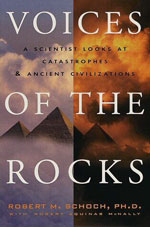
“The great 19th-century battle between catastrophists and uniformitarians seemed to end with the notion of global cataclysms being dismissed as a back door to the supernatural.
But the catastrophist theory has gradually become more and more plausible, so that now, less than a hundred years later, it is widely believed that mass extinctions are linked to meteor strikes.”
Get This Book From:
Amazon.com
Amazon.co.uk
“Voyages of the
Pyramid Builders”
by
Dr Robert M. Schoch

“Is it a mere coincidence that pyramids are found across our globe? Did cultures ranging across vast spaces in geography and time, such as the ancient Egyptians; early Buddhists; the Maya, Inca, Toltec, and Aztec civilizations of the Americas; the Celts of the British Isles; and even the Mississippi Indians of pre-Columbian Illinois, simply dream the same dreams and envision the same structures?
Get This Book From:
Amazon.com
Amazon.co.uk
Japan’s Mysterious Pyramids:
Yonaguni-jima
Only Available On NTSC DVD
Do undersea relics near Okinawa offer proof of a sophisticated civilization during the last ice age?
“Underworld: Flooded
Kingdoms of the
Ice Age”
by
Graham Hancock

Get This Book From:
Amazon.com
Amazon.co.uk
“From Graham Hancock, bestselling author of Fingerprints of the Gods, comes a mesmerizing book that takes us on a captivating underwater voyage to find the ruins of a lost civilization that’s been hidden for thousands of years beneath the world’s oceans. While Graham Hancock is no stranger to stirring up heated controversy among scientific experts, his books and television documentaries have intrigued millions of people around the world and influenced many to rethink their views about the origins of human civilization.
Now he returns with an explosive new work of archaeological detection. In Underworld, Hancock continues his remarkable quest underwater, where, according to almost a thousand ancient myths from every part of the globe, the ruins of a lost civilization, obliterated in a universal flood, are to be found.”
“Heaven’s Mirror”
by
Graham Hancock

Get This Book From:
Amazon.com
Amazon.co.uk
Hancock’s chief thesis in
“Heaven’s Mirror” is that numerous ancient sites and monuments – the pyramids of Mexico and Egypt, the ruins of Angkor Wat in Cambodia, the monuments of Yonaguni in the Pacific, and the megaliths of Peru and Bolivia – are situated in such a way, geodetically, that they point towards some separate and uniform influence, some lost civilization or “invisible college” of astronomer-priests.
Japan’s Mysterious Pyramids:
Yonaguni-jima
Only Available
On NTSC DVD
Do undersea relics near Okinawa offer proof of a sophisticated civilization during the last ice age?
The Morien Institute
Research Projects
if you would like to support our marine archaeology research
please send us a book

from our Wish List
|
|
In September 1997, Dr Robert M. Schoch, a geology professor from Boston University, went to Japan to examine an enigmatic structure that had been discovered in 1985 off the coast of the southernmost Japanese island of Yonaguni Jima. He had been invited by the writer, Graham Hancock, to give his opinion as to whether or not the structure was ‘natural’ in origin or ‘man-made’. The expedition was to be filmed for a series of three television documentaries, the “Quest for the Lost Civilisation” trilogy, which accompanied the release of Hancock’s book, “Heaven’s Mirror”.
Below, over three webpages, Dr Schoch expalins why he feels the structure is “…
primarily, possibly totally, a natural structure.”. But not all geologists are in agreement with Dr Schoch, and recent discoveries off the coast of Cuba, and in India, in the Gulf of Cambay, make it more likely that the Yonaguni structure is at least ‘terraformed’ – that is, originally a natural structure whose features have been enhanced by human hands.
The recent (February/March 2002) programmes on UK Channel 4, “Flooded Kingdoms of the Ice Age”, which accompanied the release of Graham Hancock’s latest (February 2002) book “Underworld”, detail the recent discoveries that have been found in depths of up to 300 feet of water on various coastal shelves, and in the mediterranean around Malta.
These discoveries show quite clearly that, during the last Ice Age, civilisation flourished on what were then the coastal areas of the many parts of the world which, despite glaciations further north, still enjoyed a very pleasant, temperate climate. These ancient settlements are proving to have been much more advanced urban cities than current models of prehistory are prepared to acknowledge, but their existence is just as real as the fact that they were obviously flooded during the abrupt end of the last Ice Age, at the Pleistocene/Holocene boundary.
Dr Schoch has worked on Yonaguni Jima with the respected marine geologist, Prof. Masaaki Kimura, of the University of the Ryukyus in Okinawa, who has for several years been studying the underwater structures that have been found in the immediate Yonaguni area since the first structure was discovered by a dive-tour operator, Kihachiro Aratake, whilst diving for sharks in 1985. Prof. Kimura is convinced that they are all man-made, but Dr Schoch feels otherwise.
Dr. Robert M. Schoch is a tenured associate professor of science and mathematics at Boston University’s College of General Studies. Trained as a geologist (Ph.D. in geology and geophysics from Yale University), Dr. Schoch has done field research in the Canadian High Arctic, the western United States, Pakistan, Egypt, and recently Japan.
The following text is the original draft in English, of the article that was published in Spanish as: “Schoch, Robert M., 1999, La Piramide de Yonaguni: Recuerdo de Mu?” Mas Alla de la Ciencia. No. 125 (May 1999), pp. 20-25. The Yonaguni Monument is discussed in greater detail, with many photographs, in Dr Schoch’s book “Voices of the Rocks”.
“For many decades, indeed for centuries and even millennia, various researchers and writers have searched for the truth behind Plato’s lost continent of Atlantis (usually, but not always, considered to have been located in either the Mediterranean Sea or in the Atlantic Ocean), or for the presumed sister continent of Atlantis in the Indian or Pacific Ocean, referred to variously as Mu or Lemuria. By a literal interpretation of Plato’s chronology, Atlantis was destroyed cataclysmically around 9500-9600 B.C., and the supposed civilization of Mu is thought to have been even older.
Now remains that are considered by some people to be tangible evidence of a lost, highly sophisticated, and very ancient civilization have been located in the Okinawa area under the sea. Could this be Mu or Lemuria?
The structures that have been discovered thus far are all located off the coasts of Okinawa and various islands of the Ryukyu Island chain, Japan. The best publicized and most spectacular of these structures is one located off the southern coast of Yonaguni Island, a small (approximately 10 km by 4 km) Japanese island located east of Taiwan and west of Ishigaki and Iriomote Islands in the East China Sea.
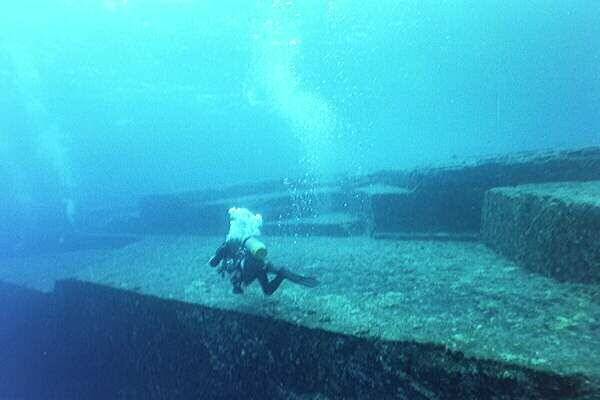
Copyright 1999 Dr. Robert M. Schoch
The structure off the coast of Yonaguni has been hailed as “the world’s oldest building” (Barot, 1998), taking the form of a “stone ziggurat” dating back to 8000 B.C. (Barot, 1998).
If this is actually the case, this could prove to be one of the most important archaeological discoveries of the last fifty years.
In order to evaluate the site, I have visited Yonaguni on two separate occasions (in September 1997 at the invitation of the Japanese businessman Mr. Yasuo Watanabe, and during July-August 1998 as a member of the “Team Atlantis” underwater archaeological project)
.
On each trip I made several dives on the site. The “Yonaguni Monument”, as I refer to this structure, superficially has the appearance of a platform-like or partial step-pyramid-like structure. It has been compared to various pyramidal and temple structures in the Americas, such as the ancient “Temple of the Sun” near Trujillo in northern Peru (Joseph, 1997, pp. 4-5).
The Yonaguni Monument is over 50 meters long in an east-west direction and over 20 meters wide in a north-south direction. The top of the structure lies about 5 meters below sea level, whereas the base is approximately 25 meters below the surface.
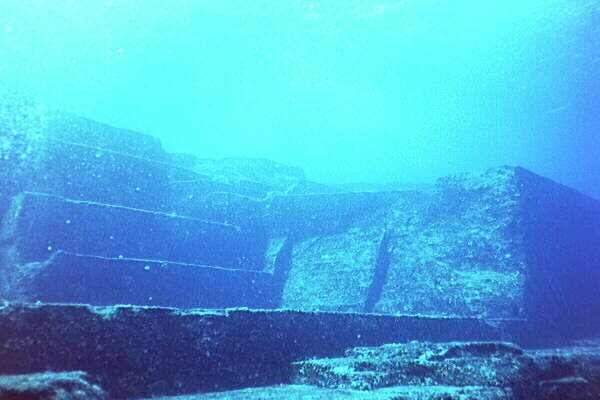
Copyright 1999 Dr. Robert M. Schoch
It is an asymmetrical structure with what appear to be titanic stone steps exposed on its southern face. These steps range from less than half a meter to several meters in height.
When viewing photographs of the Yonaguni Monument many people immediately have the impression, due to the regularity of the stone faces of the steps and the sharp angles made by the rock, that this is an artificial structure.
The rock faces appear to be dressed stone. If this is an artificial, man-made structure then it is reasonable to assume that it was built or carved not underwater but at a time when this area was above sea level.
Indeed, this area has experienced major rises in sea levels during and since the Pleistocene (“Ice Age”) and based on well-established standard curves of sea-level rises in the region, as recently as 8,000 to 10,000 years ago the Yonaguni Monument may have been above local sea level. Thus we can suggest with some confidence that if the Yonaguni Monument is a man-made construction then it must be at least 8,000 years old.
Dr. Masaaki Kimura, a professor in the Department of Physics and Earth Sciences at the University of the Ryukyus, Okinawa, has carried out an extensive underwater mapping project of the Yonaguni Monument.
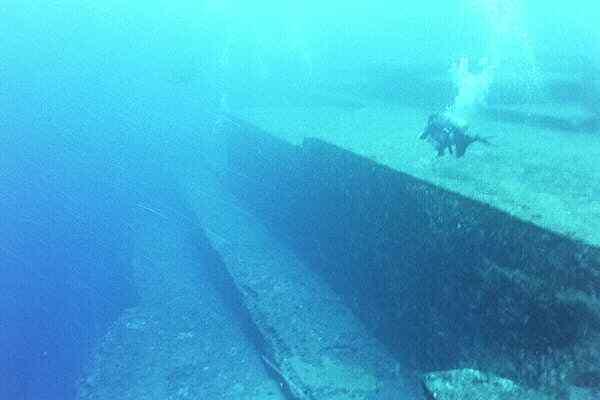
Copyright 1999 Dr. Robert M. Schoch
During my trips to Japan I have had the opportunity to visit with Dr. Kimura several times, both on site in Yonaguni and in his office in Okinawa.
Based on his research, Dr. Kimura has espoused the view that the Yonaguni Monument is, on the whole, an artificial structure.
If this is the case, then the Yonaguni monument appears to bear testimony to a previously unknown, yet very early and highly sophisticated civilization (possibly linked to the Angkor Wat temples in Cambodia? JM).
Dr Robert M. Schoch’s Yonaguni
investigation continues on
page two
Compare Dr Schoch’s views on the
Yonaguni structure with
the radically different views
of Prof. Masaaki Kimura
Read Dr Schoch’s views on the
ancient rainwater-erosion controversy
of Egypt’s Great Sphinx
History’s Mysteries
“Do undersea relics near Okinawa offer proof of a sophisticated civilization during the last ice age?
Archeologists have long believed that civilization as they define it — intelligent, tool-making, monument building, social humans — began about 5,000 years ago.
But submerged beneath the waves near the Japanese island of Yonaguni is evidence that may well overturn that long-held theory.
A small but persuasive number of scholars and scientists have long thought that “advanced” societies may have existed as long as 10,000 years ago.
Their theories, however well reasoned and defended, have been hamstrung by a lack of evidence.
But recent discoveries of man-made artifacts on the Pacific seafloor may well prove to be the smoking gun that will propel this alternative view of civilization to prominence”.
see the evidence with ‘unique underwater footage’
of the various Yonaguni structures in the
‘History Channel’ TV programme
“Japan’s Mysterious Pyramids”
NTSC DVD
or
VHS
|
|
Books about the ancient Jomon of prehistoric Japan
“Ancient Jomon of Japan”
by
Junko Habu

Get This Book From:
Amazon.com
Amazon.co.uk
“Prehistoric Japan:
New Perspectives on Insular East Asia”
by
Keiji Imamura

Get This Book From:
Amazon.com
Amazon.co.uk
“Jomon of Japan: The World’s Oldest Pottery”
by
Douglas Moore Kenrick
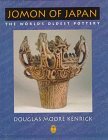
Get This Book From:
Amazon.com
Amazon.co.uk
“In the Wake of Jomon: Stone Age Mariners and a Voyage Across
the Pacific”
by
Jon Turk
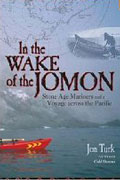
Get This Book From:
Amazon.com
Amazon.co.uk
“An Archaeological History of Japan, 30,000 B.P. to A.D. 700”
by
Koji Mizoguchi

Get This Book From:
Amazon.com
Amazon.co.uk
“Origins of the Sphinx:
Celestial Guardian of Pre-Pharaonic Civilization”
by
Robert M. Schoch Ph.D.
and
Robert Bauval
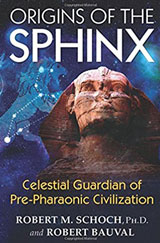
Get This Book From:
Amazon.com
Amazon.co.uk
“Sacred Texts and Buried Treasure:
Issues on the Historical Archaeology of
Ancient Japan”
by
William Wayne Farris

Get This Book From:
Amazon.com
Amazon.co.uk
“Shintao: The Sacred Art of Ancient Japan”
by
Victor Harris
(Editor)
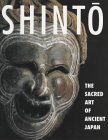
Get This Book From:
Amazon.com
Amazon.co.uk
Books About
Marine Archaeoloy
“Basic Decompression Theory and Application, Second Edition”
by
Bruce R. Wienke

Get This Book From:
Amazon.com
Amazon.co.uk
|